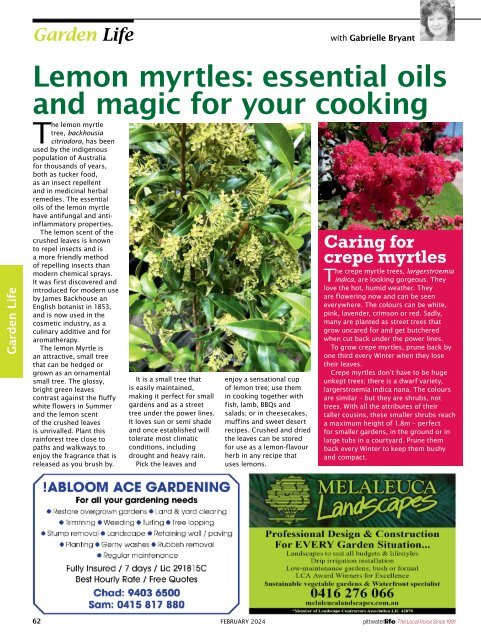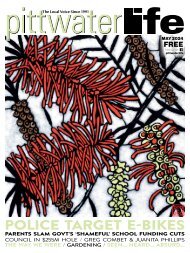Pittwater Life Febraury 2024 Issue
LAND VALUES QUERIED 1991AUSSIE-FIRST: BAYVIEW’S NEW ELECTRIC BOAT CHARGER GUIDE TO LOCAL SMALL GYMS / SAILOR JOHN FORBES SEEN... HEARD... ABSURD... / AV SOCCER / THE WAY WE WERE
LAND VALUES QUERIED
1991AUSSIE-FIRST: BAYVIEW’S NEW ELECTRIC BOAT CHARGER GUIDE TO LOCAL SMALL GYMS / SAILOR JOHN FORBES SEEN... HEARD... ABSURD... / AV SOCCER / THE WAY WE WERE
Create successful ePaper yourself
Turn your PDF publications into a flip-book with our unique Google optimized e-Paper software.
Garden <strong>Life</strong><br />
with Gabrielle Bryant<br />
Garden <strong>Life</strong><br />
Lemon myrtles: essential oils<br />
and magic for your cooking<br />
The lemon myrtle<br />
tree, backhousia<br />
citriodora, has been<br />
used by the indigenous<br />
population of Australia<br />
for thousands of years,<br />
both as tucker food,<br />
as an insect repellent<br />
and in medicinal herbal<br />
remedies. The essential<br />
oils of the lemon myrtle<br />
have antifungal and antiinflammatory<br />
properties.<br />
The lemon scent of the<br />
crushed leaves is known<br />
to repel insects and is<br />
a more friendly method<br />
of repelling insects than<br />
modern chemical sprays.<br />
It was first discovered and<br />
introduced for modern use<br />
by James Backhouse an<br />
English botanist in 1853,<br />
and is now used in the<br />
cosmetic industry, as a<br />
culinary additive and for<br />
aromatherapy.<br />
The lemon Myrtle is<br />
an attractive, small tree<br />
that can be hedged or<br />
grown as an ornamental<br />
small tree. The glossy,<br />
bright green leaves<br />
contrast against the fluffy<br />
white flowers in Summer<br />
and the lemon scent<br />
of the crushed leaves<br />
is unrivalled. Plant this<br />
rainforest tree close to<br />
paths and walkways to<br />
enjoy the fragrance that is<br />
released as you brush by.<br />
It is a small tree that<br />
is easily maintained,<br />
making it perfect for small<br />
gardens and as a street<br />
tree under the power lines.<br />
It loves sun or semi shade<br />
and once established will<br />
tolerate most climatic<br />
conditions, including<br />
drought and heavy rain.<br />
Pick the leaves and<br />
enjoy a sensational cup<br />
of lemon tree; use them<br />
in cooking together with<br />
fish, lamb, BBQs and<br />
salads; or in cheesecakes,<br />
muffins and sweet desert<br />
recipes. Crushed and dried<br />
the leaves can be stored<br />
for use as a lemon-flavour<br />
herb in any recipe that<br />
uses lemons.<br />
Caring for<br />
crepe myrtles<br />
The crepe myrtle trees, largerstroemia<br />
indica, are looking gorgeous. They<br />
love the hot, humid weather. They<br />
are flowering now and can be seen<br />
everywhere. The colours can be white,<br />
pink, lavender, crimson or red. Sadly,<br />
many are planted as street trees that<br />
grow uncared for and get butchered<br />
when cut back under the power lines.<br />
To grow crepe myrtles, prune back by<br />
one third every Winter when they lose<br />
their leaves.<br />
Crepe myrtles don’t have to be huge<br />
unkept trees; there is a dwarf variety,<br />
largerstroemia indica nana. The colours<br />
are similar – but they are shrubs, not<br />
trees. With all the attributes of their<br />
taller cousins, these smaller shrubs reach<br />
a maximum height of 1.8m – perfect<br />
for smaller gardens, in the ground or in<br />
large tubs in a courtyard. Prune them<br />
back every Winter to keep them bushy<br />
and compact.<br />
62 FEBRUARY <strong>2024</strong><br />
The Local Voice Since 1991
















